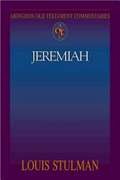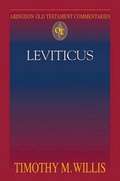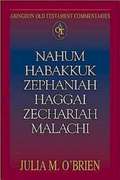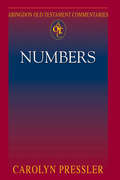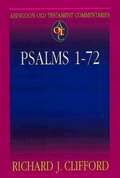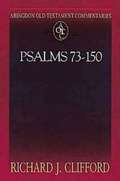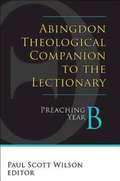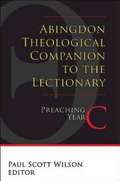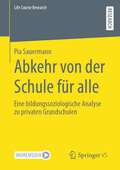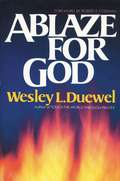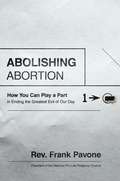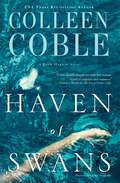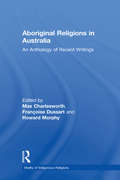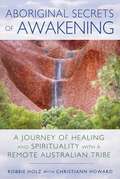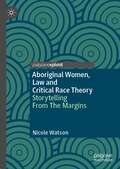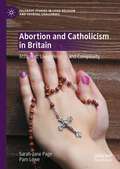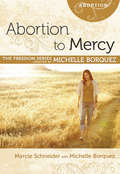- Table View
- List View
Abingdon Old Testament Commentaries: I & II Chronicles (Abingdon Old Testament Commentaries)
by Steven L. McKenzieThe Abingdon Old Testament Commentaries provide compact, critical commentaries on the books of the Old Testament for the use of theological students and pastors. The commentaries are also useful for upper-level college or university students and for those responsible for teaching in congregational settings. In addition to providing basic information and insights into the Old Testament writings, these commentaries exemplify the tasks and procedures of careful interpretation, all to assist students of the Old Testament in coming to an informed and critical engagement with the biblical texts themselves. The present volume gives an up-to-date, readable commentary on the books of First and Second Chronicles. The commentary covers critical issues section by section while emphasizing the larger theological and literary issues in Chronicles and illustrating its relevance for modern readers.
Abingdon Old Testament Commentaries: Jeremiah As Symbolic Tapestry (Abingdon Old Testament Commentaries #No. 260)
by Louis StulmanThe Abingdon Old Testament Commentaries provide compact, critical commentaries on the books of the Old Testament for the use of theological students and pastors. The commentaries are also useful for upper-level college or university students and for those responsible for teaching in congregational settings. In addition to providing basic information and insights into the Old Testament writings, these commentaries exemplify the tasks and procedures of careful interpretation, to assist students of the Old Testament in coming to an informed and critical engagement with the biblical texts themselves.Jeremiah has a reputation for being one of the most difficult books in the Bible to read. Despite its dense and jumbled appearance, Stulman shows that Jeremiah is far more than a random accumulation of miscellaneous materials. Jeremiah is an artistic and symbolic tapestry held together by prose seams. In the first commentary to give the prose literature such strong attention, Stulman explains how the prophetic book reenacts the dismantling of Israel's most cherished social and symbolic systems. In doing so it speaks poignantly of the horrors of war and military occupation, as well as the resultant despair and anger. Siege and deportation, however, do not signal the end for the people of God. As Jeremiah unfolds, seeds of hope begin to emerge. Such hope asserts that massive wreckage does not nullify God's love, that oppressive and murderous forces will not ultimately triumph, and that the suffering and sovereign God will sculpt new beginnings out of the ruin of fallen worlds.
Abingdon Old Testament Commentaries: Lamentations (Abingdon Old Testament Commentaries)
by Dianne BergantThe Abingdon Old Testament Commentaries series offers compact, critical commentaries on all the books of the Old Testament. In addition to providing fundamental information on and insights into Old Testament writings, these commentaries exemplify the tasks and procedures of careful, critical exegesis so as to assist students of the Old Testament in coming to an informed engagement of the biblical texts themselves. These commentaries are written with special attention to the needs and interests of theology students, but they will also be useful for students in upper-level college or university settings, as well as for pastors and other church leaders. Each volume consists of four parts: -- an introduction that addresses the key issues raised by the writing; the literary genre, structure, and character of the writing; the occasional and situational context of the writing, including its wider social and historical context; and the theological and ethical significance of the writing within these several contexts-- a commentary on the text, organized by literary units, covering literary analysis, exegetical analysis, and theological and ethical analysis-- an annotated bibliography-- a brief subject index Bergant's commentary opens to students and pastors the visceral poetry of Lamentations, a book that plumbs the depth of biblical Israel's despair over the destruction of Jerusalem. The security of Jerusalem signaled divine protection of the whole nation, so Jerusalem's destruction was perceived as a sign that God had abandoned the entire people. The book of Lamentations is a cry to God for mercy. The horrors detailed within its five short chapters reveal the extent of human cruelty and the resiliency of the human spirit to endure such cruelty. Unlike many biblical books, Lamentations ends on an unresolved note. Will God eventually hear the cry of the people? Will God, as in days gone by, step in with mercy and salvation?
Abingdon Old Testament Commentaries: Leviticus (Abingdon Old Testament Commentaries)
by Timothy M. WillisThe Abingdon Old Testament Commentaries provide compact, critical commentaries on the books of the Old Testament for the use of theological students and pastors. The commentaries are also useful for upper-level college or university students and for those responsible for teaching in congregational settings. In addition to providing basic information and insights into the Old Testament writings, these commentaries exemplify the tasks and procedures of careful interpretation, to assist students of the Old Testament in coming to an informed and critical engagement with the biblical texts themselves.Leviticus is one of those OT books that modern readers tend to avoid on the basis of an undeserved reputation alone. Many assume that its laws and instructions – especially those concerning animal sacrifices – are irrelevant to the religious life of Western readers. This assumption does not take into account the theological principles demonstrated by these teachings and demonstrated in the cultic rituals and affairs of daily life mentioned in the book. Within the narrative arc of the Pentateuch, the laws of Leviticus represent a program for restoring the original created order, an order that has been disrupted by human sin. Leviticus prepares for and presents a world that is to be dominated by life, which is manifested by humans in cultic purity and daily holiness. As such, the book constitutes a challenge and an encouragement to believers of every generation, as they strive to live the life that God originally intended for humanity.
Abingdon Old Testament Commentaries: Minor Prophets (Abingdon Old Testament Commentaries)
by Daniel J. SimundsonThe Abingdon Old Testament Commentaries provide compact, critical commentaries on the books of the Old Testament for the use of theological students and pastors. The commentaries are also useful for upper-level college or university students and for those responsible for teaching in congregational settings. In addition to providing basic information and insights into the Old Testament writings, these commentaries exemplify the tasks and procedures of careful interpretation to assist students of the Old Testament in coming to an informed and critical engagement with the biblical texts themselves.The prophetic books gathered together in the book of the Twelve are sometimes called the "minor" prophets because of their relatively small size when compared with Isaiah, Jeremiah, and Ezekiel. They are often neglected, at least partly because their words of judgment make the reader uncomfortable. Yet they have considerable theological and ethical value--for their call for social justice (especially Amos and Micah), their insights about the passionate love of God (in Hosea), God's grace and forgiveness (Jonah, Hosea, and elsewhere), and the finality of hope, even in the face of terrible catastrophes.
Abingdon Old Testament Commentaries: Nahum, Habakkuk, Zephaniah, Haggai, Zechariah, Malachi (Abingdon Old Testament Commentaries)
by Julia M. O'BrienThe Abingdon Old Testament Commentaries provide compact, critical commentaries on the books of the Old Testament for the use of theological students and pastors. The commentaries are also useful for upper-level college or university students and for those responsible for teaching in congregational settings. In addition to providing basic information and insights into the Old Testament writings, these commentaries exemplify the tasks and procedures of careful interpretation, all to assist students of the Old Testament in coming to an informed and critical engagement with the biblical texts themselves.The six books found at the close of the Minor Prophets (Nahum, Habakkuk, Zephaniah, Haggai, Zechariah, and Malachi) present distinctive understandings of God, humanity, and the future. This commentary engages those understandings, considers what the books may have meant in the past, and describes how they resonate with contemporary readers. With attention to issues of gender, violence, and inclusivity, O'Brien explores the ethical challenges of the books and asks how faithful readers can both acknowledge the problems these biblical books raise and appreciate their value for contemporary theological reflection.
Abingdon Old Testament Commentaries: Numbers (Abingdon Old Testament Commentaries)
by Carolyn PresslerThe Abingdon Old Testament Commentaries provide compact, critical commentaries on the books of the Old Testament for the use of theological students and pastors. The commentaries are also useful for upper-level college or university students and for those responsible for teaching in congregational settings. In addition to providing basic information and insights into the Old Testament writings, these commentaries exemplify the tasks and procedures of careful interpretation, to assist students of the Old Testament in coming to an informed and critical engagement with the biblical texts themselves. The present volume gives an up-to-date, readable commentary on the book of Numbers. The commentary covers critical issues section by section while emphasizing the larger theological and literary issues in Numbers and illustrating its relevance for modern readers.
Abingdon Old Testament Commentaries: Psalms 1-72 (Abingdon Old Testament Commentaries #Vol. 22)
by Richard J. CliffordClifford differs from other commentators on the Psalms chiefly in his concern with the inner dramatic logic of the Psalms - how they organize the experience and desires of the "pray-er" and bring them to a proper conclusion. His primary concern is to help readers see the pattern and progression within the Psalms, while at the same time attending to the richness of their words and the texture of their imagery.
Abingdon Old Testament Commentaries: Psalms 73-150 (Abingdon Old Testament Commentaries)
by Richard J. CliffordThis second volume completes Richard Clifford's Commentary on the Psalms. The rich imagery of the Psalms has guided and molded pray-ers since ancient times. As we seek to understand the threads and colors of the Psalms, Clifford helps us see their inner dramatic logic, how they organize the experience and desires of the pray-er, and how they seek to move us. His primary concern is to help readers see the pattern and progression within the Psalms, while attending to their complex, evocative nature.
Abingdon Old Testament Commentaries: Ruth (Abingdon Old Testament Commentaries)
by Judy Fentress-WilliamsFrom the Introduction: Described by Goethe as “the most charming little whole” of antiquity, Ruth has long been recognized for its literary quality. This beautifully composed narrative continues to attract readers across generations and boundaries of gender, class and ethnicity. In fact, the beauty of the book often distracts from the practical nature of the narrative. For all of its appeal, Ruth is, after all a story about family and survival. The marriage between Ruth and Boaz is a levirate marriage. The goal of this practice is to ensure the continuation and stability of the family line. Thus this “charming little whole” has as its subject preservation of life in the face of death and upholding memory to ward off the loss of identity.This story of survival is short; it consists of four chapters with elements of loss and recovery; famine and harvest, barrenness and fruitfulness, life and death. These elements afford the book a broad appeal as it speaks to various stages and seasons of life, all the while upholding the power of faithfulness against an ever-changing backdrop. Named after one of the major characters, the book of Ruth tells the story of Naomi of Bethlehem and her family “in the days when the judges ruled.”So much of what happens in Ruth happens where no one can see. Ruth binds herself to Naomi in the “in between place” of Moab and Judah. No one is there to witness it. Similarly, Ruth asks Boaz for redemption in the middle of the night when we presume everyone else is asleep. These events allow for the inclusion of Ruth as Boaz’s people, first as a gleaner and then as a wife. The pattern of what happens away from our observation and then bursts forth where we can see it draws on the images of planting and harvest, conception and birth. On a theological level, it suggests that even in the famine times, God is planting seed, preparing for the next harvest, even when we cannot see it. We must assume then, that whatever we know or recognize about the work of God is only a small piece of the larger whole. We cannot know it all. Chapters:Introduction A Dialogue of Determination Terms of Endearment A Cloaked Covenant A Dialogue of IdentityConclusion
Abingdon Theological Companion to the Lectionary: Preaching Year A
by Paul Scott Wilson Parkes Rev Sam PersonsThe Abingdon Theological Companion to the Lectionary begins with the conviction that Scripture speaks first and foremost to Christians now. Its message engages Christian belief and action in the present day. While informed by the best in current biblical studies, its commentary on the Scripture passages of the Revised Common Lectionary focuses on the questions of Christian life in the world that church members bring to worship. Each entry is co-written by a theologian and homiletician and seeks to answer the questions, "What does this passage say about the gospel and how does it speak to my encounter with God in Christ and my calling as a Christian in the world?"This volume showcases theological matters that arise from the biblical texts in the lectionary and from the church seasons and special days. This important resource draws upon recent scholarship in various disciplines with a view to enriching the theological contribution of sermons in the years to come.
Abingdon Theological Companion to the Lectionary: Preaching Year B
by Paul Scott Wilson Cynthia L. RigbyThe Abingdon Theological Companion to the Lectionary begins with the conviction that Scripture speaks first and foremost to Christians now. Its message engages Christian belief and action in the present day. While informed by the best in current biblical studies, its commentary on the Scripture passages of the Revised Common Lectionary focuses on the questions of Christian life in the world that church members bring with them to worship. Each entry seeks to answer the essential questions, "what does this passage say about the Gospel? How does it speak to my encounter with God in Christ, and my calling as a Christian in the world?" This volume is conceived as a companion to biblical and lectionary resources that preachers regularly employ. It showcases theological matters that arise out of both the biblical texts in the lectionary and the church seasons and special days.
Abingdon Theological Companion to the Lectionary: Preaching Year C
by Paul Scott WilsonThe point of the Revised Common Lectionary is to allow God's people to encounter the meaning of Scripture through the Word read and proclaimed. Yet too many lectionary resources fail to help in that task. In fact, they often confront the preacher with a choice between poor options: in-depth commentary focused too heavily on the historical world of the text; or shallow suggestions for "life applications" that have too little to do with the real world. Christians are called to an engagement with the deep meaning of Scripture; preachers are called to help them do that. But where can they turn for resources that will make this possible? The Abingdon Theological Companion to the Lectionary begins with the conviction that Scripture speaks first and foremost to Christians now. Its message engages Christian belief and action in the present day. While informed by the best in current biblical studies, its commentary on the Scripture passages of the Revised Common Lectionary focuses on the questions of Christian life in the world that church members bring with them to worship. Each entry is co-written by a Theologian and a Homiletician and seeks to answer the essential questions, "what does this passage say about the Gospel? How does it speak to my encounter with God in Christ, and my calling as a Christian in the world?" This volume is conceived as a companion to biblical and lectionary resources that preachers regularly employ. It showcases theological matters that arise out of both the biblical texts in the lectionary and the church seasons and special days. This important resource will draw upon recent scholarship in various disciplines with a view to enriching the theological contribution of sermons in the years to come. The result will be a volume that has broad ecumenical appeal and that preachers will want at their fingertips. This volume is for The Revised Common Lectionary Year C.
Abingdon Worship Annual 2026
by Mary Scifres B.J. BeuThe go-to worship planning resource for all who plan weekly worship.The Abingdon Worship Annual 2026 is a practical, lectionary-based resource for leaders responsible for planning worship. This thoughtful sourcebook offers a weekly theme with meaningful prayers and fresh litanies following a traditional order of Christian worship: Invitation and Gathering Proclamation and Response Thanksgiving and Communion Sending Forth Liturgies and prayers are also included for special days, including New Year’s Day, Ascension Day, All Saints Day, Thanksgiving Day, and Christmas Eve.The Annual includes helpful reminders for Christian-year planning—including liturgical colors—and a scripture index. The authors also provide in-depth guidance and practical ideas for this new age of worship, helping readers understand and weigh their options for worshiping in digital spaces and unconventional places.The Abingdon Worship Annual 2026 is a must-have sourcebook offering countless opportunities for planning meaningful and insightful worship.
Abirami Andhadhi
by Abirami Pattar Kavingar KannadasanWhen Abirami Pattar's life was in danger,the Goddess Abirami manifested herself before pattar to save his life and threw her thadanga over the sky such that it shined with bright light upon the horizon.The hymns on the Goddess sung by the pattar is Abhirami Andhadhi.
Abkehr von der Schule für alle: Eine bildungssoziologische Analyse zu privaten Grundschulen (Life Course Research)
by Pia SauermannVor dem Hintergrund eines expandierenden Privatschulsektors einerseits und der Konzeption der für allen gemeinsamen Grundschule andererseits untersucht die vorliegende Arbeit, ob private Grundschulen in Deutschland Bildungsungleichheiten verstärken. Betrachtet werden einerseits die Selektivität der Privatschulwahl und andererseits die Effekte, welche der Besuch einer privaten Grundschule auf die Kompetenzentwicklung hat. Beide Aspekte werden auf Basis von Daten des Nationalen Bildungspanels untersucht. Die Befunde weisen darauf hin, dass die Wahl einer privaten Grundschule insbesondere in städtischen Gebieten und in Ostdeutschland vom Bildungsniveau und vom kulturellen Kapital der Eltern abhängt. Wird die soziale Selektivität der Privatschulwahl berücksichtigt, zeigt sich kein Effekt privater Beschulung auf die Entwicklung von Lese- und Mathematikkompetenzen.
Ablaze for God
by Wesley L. Duewel Robert E. ColemanWhat are the spiritual dynamics of leadership? How can you be more a person of God, aflame for God, anointed and empowered by God -- truly a Spirit-filled leader? Here are answers that you will read again and again.
Abolishing Abortion
by Frank PavoneThe struggle against abortion in our nation has been going on a long time. Sometimes it seems like an evil that will never go away. People want to get involved in the fight, but it feels futile, and increasingly the culture tells Christians to stay out of politics. Longtime activist Rev. Frank Pavone counters this frustrated mindset with challenge, encouragement, plain facts, and a healthy dose of strategy. He explores biblical, moral, historical, and legal reasons Christians belong in the public square and challenges both churches and individual Christians to full engagement. Pavone argues convincingly that the battle against abortion not only can be won, but must be won. The soul of our nation depends on it.
Abomination: (previously published as Abomination) (Rock Harbor #4)
by Colleen CobleA beautiful woman stands by the side of the road, barefoot and bleeding, a child in her arms. Someone just tried to kill her, but she wouldn't recognize him if she saw his face. She doesn't even remember her own name.A suburban cop surveys a kitchen in disarray--a woman and child missing, a chilling note. This crime scene is unlike any he has ever seen.The man who calls himself Gideon waits and plans. He sees himself as a destroyer of evil, one who rids the world of abominations. He has already killed five. He will kill again. And somewhere in the wilderness, in a secret geocache near where the wild swans gather, lies the unspeakable clue that links them all together. Michigan's rugged and beautiful Upper Peninsula is the setting for this absorbing tale of love and loss, beauty and terror, grievous sins and second chances. A deftly woven thriller from the popular author of the Rock Harbor novels.
Aboriginal Environmental Knowledge: Rational Reverence (Vitality of Indigenous Religions)
by Catherine LaudineWhilst there are popular ideas about which champion Aboriginal environmental knowledge, many of these are based more on romantic notions than on any detailed understanding of what might be the content of this knowledge. This book is based on a grounded and broad assessment of less well known details of Aboriginal knowledge and provides both a great deal of detail and a new assessment of rituals and practices. Aboriginal environmental knowledge is examined here as an integrated source of both religious and scientific knowledge. An important finding is that Aboriginal environmental knowledge also includes knowledge about education for attitudes considered appropriate for survival. Though evidence for this is readily available in the literature, it has not been part of current depictions of Aboriginal environmental knowledge.
Aboriginal Religions in Australia: An Anthology of Recent Writings (Vitality of Indigenous Religions)
by Howard Morphy Françoise DussartOver the last 25 years there has been an explosion of interest in the Aboriginal religions of Australia and this anthology provides a variety of recent writings, by a wide range of scholars. Australian Aboriginal Religions are probably the oldest extant religious systems. Over some 50,000 years they have coped with change and re-invented themselves in an astonishingly creative way. The Dreaming, the mythical time when the Ancestor Spirits shaped the territories of the Aborigines and laid down a moral and ritual law for their occupants, is the fundamental religious reality. It is the basis of the Aborigines's view of their land or country, kinship relationships, ritual and art. However, the Dreaming is not a static principle since it is interpreted in different ways, as in the extraordinary movement in contemporary indigenous painting, and in attempts at an accommodation with Christianity. The contributions of anthropologists, cultural historians, philosophers of religion and others are included in this anthology which not only guides readers through the literature but also ensures this still largely inaccessible material is available to a wider range of readers and non-specialist students and academics.
Aboriginal Secrets of Awakening: A Journey of Healing and Spirituality with a Remote Australian Tribe
by Christiann Howard Robbie HolzOne woman’s story of healing through Aboriginal principles and awakening to her own healing powers • Explains principles from the 60,000-year-old Aboriginal culture of Australia that can help create transformation in your life • Details her experiences participating in secret women’s ceremonies with an Outback Aboriginal tribe • Describes how she recovered from illness, met her team of spirit guides, coped with her husband’s passing, and found that love can transcend death Sharing her journey from bedridden patient to inspired healer, Robbie Holz recounts her recovery from hepatitis C, fibromyalgia, and treatment-induced brain damage, as well as the blossoming of her own healing powers, through her work with her husband, the late healer Gary Holz, and her experiences with a remote tribe in the Outback of Australia. Robbie describes many of the miraculous healings she witnessed while working with Gary in his Aboriginal-inspired healing practice. She details the powers that Gary developed after his transformative time being healed by Aborigines, including telepathy, seeing the inner workings of his patients’ bodies, and channeling the healing energy of the universe. She discloses how Gary accessed the Dreamtime, the energy field that is the source of reality, and reveals how her work with Gary led her to an invitation to participate in secret Aboriginal women’s ceremonies in the harsh Outback desert, where her own healing powers blossomed. Through her story of healing and discovery, Robbie describes principles from the 60,000-year-old Aboriginal culture that can help create transformation in your life. She explains how she became aware of her team of spirit guides, who provide unwavering support and unconditional love through each of life’s struggles. She shares the tenderness of her husband’s final moments and how she worked past her grief to transform her relationship with him, enabling him to become an active, loving part of her spirit team and partner in her healing work.
Aboriginal Women, Law and Critical Race Theory: Storytelling From The Margins (Palgrave Studies in Race, Ethnicity, Indigeneity and Criminal Justice)
by Nicole WatsonThis book explores storytelling as an innovative means of improving understanding of Indigenous people and their histories and struggles including with the law. It uses the Critical Race Theory (‘CRT’) tool of ‘outsider’ or ‘counter’ storytelling to illuminate the practices that have been used by generations of Aboriginal women to create an outlaw culture and to resist their invisibility to law. Legal scholars are yet to use storytelling to bring the experiential knowledge of Aboriginal women to the centre of legal scholarship and yet this book demonstrates how this can be done by way of a new methodology that combines elements of CRT with speculative biography. In one chapter, the author tells the imagined story of Eliza Woree who featured prominently in the backdrop to the decision of the Supreme Court of Queensland in Dempsey v Rigg (1914) but whose voice was erased from the judgements. This accessible book adds a new and innovative dimension to the use of CRT to examine the nexus between race and settler colonialism. It speaks to those interested in Indigenous peoples and the law, Indigenous studies, Indigenous policy, Aboriginal and Torres Strait Islander history, feminist studies, race and the law, and cultural studies.
Abortion and Catholicism in Britain: Attitudes, Lived Religion and Complexity (Palgrave Studies in Lived Religion and Societal Challenges)
by Pam Lowe Sarah-Jane PageThis book details how British Catholic communities view abortion, highlighting the diversity of positions which often contrast with the official line of Catholic Church doctrine. The authors’ extensive qualitative investigation involving various Catholic constituents demonstrates the complex ways attitudes are formed. Based on interviews with priests, Catholic parishioners, anti-abortion activists and Catholics living in close proximity to activism, this book takes a lived religion approach to argue that attitudes and approaches to abortion are nuanced and contextual, with the Catholic concept of individual conscience playing a fundamental role in navigating abortion issues. Ultimately, this investigation helps to explore in much greater depth the increased liberalisation in attitudes among Catholics towards abortion, at a time when Catholic activism opposing abortion is growing, and therefore shines a light on the conflicts that are apparent at the heart of Catholic parishes. Thisbook will be of interest to scholars in Gender and Sexuality Studies, Sociology, Theology and Religious Studies.
Abortion to Mercy (The Freedom Series)
by Michelle Borquez Marcie SchneiderWhat happens after an abortion? When you can't go back and change the past, is there forgiveness or spiritual recovery? God still has a plan for you. There is always forgiveness and freedom when you turn to Jesus, this world's only redeemer. This minibook includes the story of Marcie Schneider, a woman who hid the dark secret of an abortion, a pain she had to endure alone. Let Marcie's counseling bring healing to you as she shares her story of redemption. This minibook will help you discover how to forgive yourself.After Marcie was pressured into having sex with someone at a party at fifteen years old, her first abortion was monumental in the steps she took thereafter. Feeling weak and invaluable, Marcie continued to seek happiness in the temporary satisfactions of this world. Though Marcie knew that there was more in this world for her than the anger she felt, she didn't realize how close she was to feeling complete freedom in Christ's mercy.Abortion to Mercy includes a Bible study by Paige Henderson that highlights the mercy that Christ has on us, despite sins we've committed. We don't always understand his love and forgiveness for us, which makes it hard for us to love and forgive others. Paige shows you verses from the Bible that will give you wisdom and hope for God's plan for your life.Abortion to Mercy will bring you hope and wholeness. It will speak to your heart and will strengthen your faith. It includes questions and Scripture passages -- along with space to journal.

